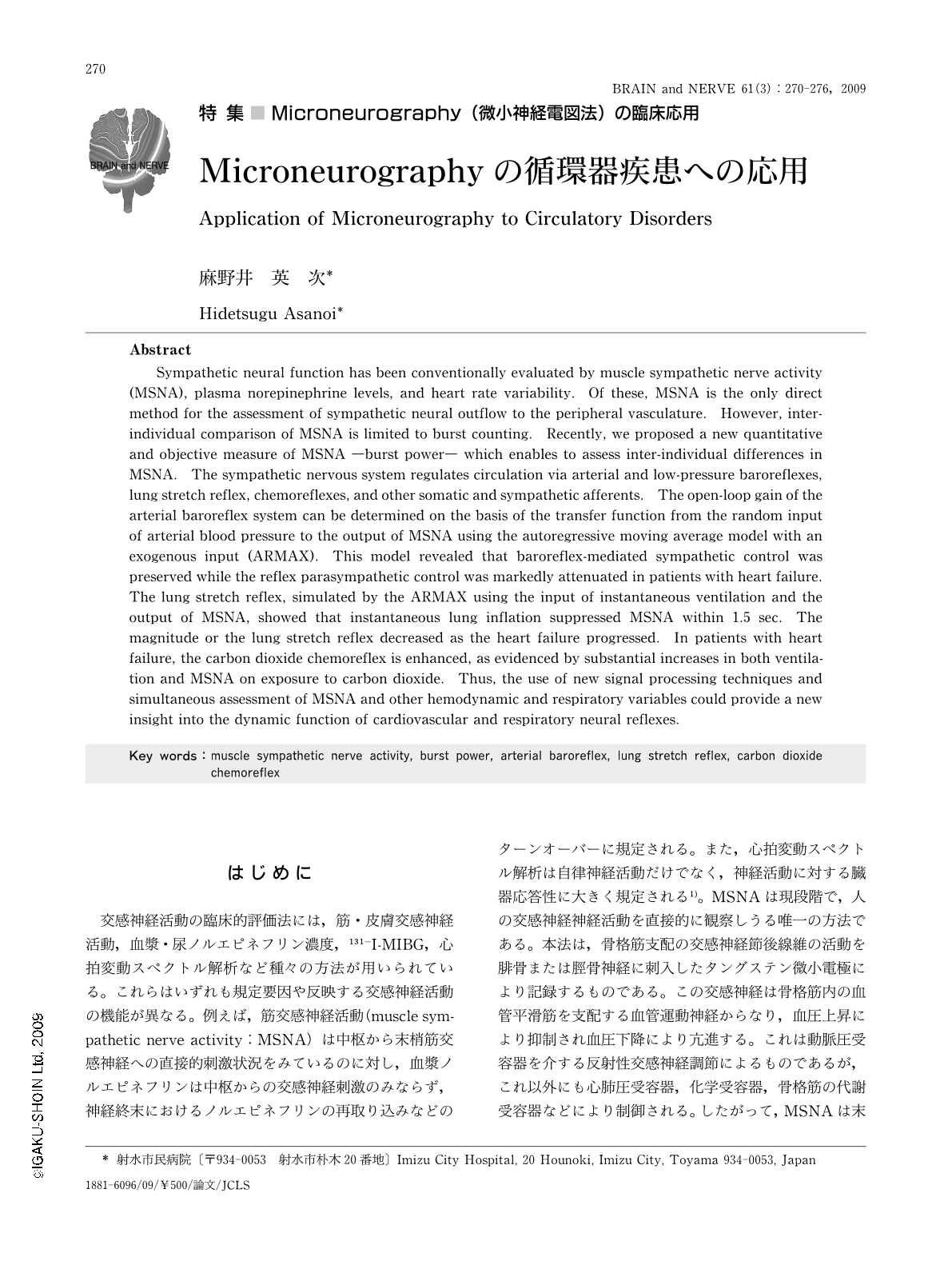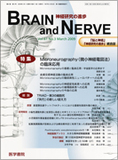Japanese
English
- 有料閲覧
- Abstract 文献概要
- 1ページ目 Look Inside
- 参考文献 Reference
はじめに
交感神経活動の臨床的評価法には,筋・皮膚交感神経活動,血漿・尿ノルエピネフリン濃度,131-I-MIBG,心拍変動スペクトル解析など種々の方法が用いられている。これらはいずれも規定要因や反映する交感神経活動の機能が異なる。例えば,筋交感神経活動(muscle sympathetic nerve activity:MSNA)は中枢から末梢筋交感神経への直接的刺激状況をみているのに対し,血漿ノルエピネフリンは中枢からの交感神経刺激のみならず,神経終末におけるノルエピネフリンの再取り込みなどのターンオーバーに規定される。また,心拍変動スペクトル解析は自律神経活動だけでなく,神経活動に対する臓器応答性に大きく規定される1)。MSNAは現段階で,人の交感神経神経活動を直接的に観察しうる唯一の方法である。本法は,骨格筋支配の交感神経節後線維の活動を腓骨または脛骨神経に刺入したタングステン微小電極により記録するものである。この交感神経は骨格筋内の血管平滑筋を支配する血管運動神経からなり,血圧上昇により抑制され血圧下降により亢進する。これは動脈圧受容器を介する反射性交感神経調節によるものであるが,これ以外にも心肺圧受容器,化学受容器,骨格筋の代謝受容器などにより制御される。したがって,MSNAは末梢血管抵抗を規定する交感神経活動の強さだけでなく,循環を制御している反射調節系の働きに関する重要な情報を提供する。本稿では,交感神経活動の亢進が著しい心不全を中心に,循環器疾患へのMSNAの応用を提示する。
Abstract
Sympathetic neural function has been conventionally evaluated by muscle sympathetic nerve activity (MSNA),plasma norepinephrine levels,and heart rate variability. Of these,MSNA is the only direct method for the assessment of sympathetic neural outflow to the peripheral vasculature. However,inter-individual comparison of MSNA is limited to burst counting. Recently,we proposed a new quantitative and objective measure of MSNA ―burst power― which enables to assess inter-individual differences in MSNA. The sympathetic nervous system regulates circulation via arterial and low-pressure baroreflexes,lung stretch reflex,chemoreflexes,and other somatic and sympathetic afferents. The open-loop gain of the arterial baroreflex system can be determined on the basis of the transfer function from the random input of arterial blood pressure to the output of MSNA using the autoregressive moving average model with an exogenous input (ARMAX). This model revealed that baroreflex-mediated sympathetic control was preserved while the reflex parasympathetic control was markedly attenuated in patients with heart failure. The lung stretch reflex,simulated by the ARMAX using the input of instantaneous ventilation and the output of MSNA,showed that instantaneous lung inflation suppressed MSNA within 1.5 sec. The magnitude or the lung stretch reflex decreased as the heart failure progressed. In patients with heart failure,the carbon dioxide chemoreflex is enhanced,as evidenced by substantial increases in both ventilation and MSNA on exposure to carbon dioxide. Thus,the use of new signal processing techniques and simultaneous assessment of MSNA and other hemodynamic and respiratory variables could provide a new insight into the dynamic function of cardiovascular and respiratory neural reflexes.

Copyright © 2009, Igaku-Shoin Ltd. All rights reserved.


